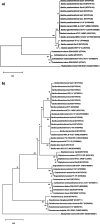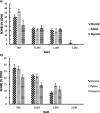Biopolymer production by halotolerant bacteria isolated from Caatinga biome
- PMID: 33491139
- PMCID: PMC8105489
- DOI: 10.1007/s42770-021-00426-1
Biopolymer production by halotolerant bacteria isolated from Caatinga biome
Abstract
Saline environments are extreme habitats with a high diversity of microorganisms source of a myriad of biomolecules. These microorganisms are assigned as extremophiles recognized to be producers of new natural compounds, which can be synthesized by helping to survive under harshness and extreme conditions. In Brazil, in the saline and semi-arid region of Areia Branca (Caatinga biome), halotolerant bacteria (able to growth at high NaCl concentrations) were isolated from rhizosphere of native plants Blutaparon portulacoides and Spergularia sp. and their biopolymer production was studied. A total of 25 bacterial isolates were identified at genus level based on 16S rRNA gene sequence analysis. Isolates were mainly Gram-positive bacteria from Bacillaceae, Staphylococcaceae, Microbacteriaceae, and Bacillales XII incertae sedis families, affiliates to Bacillus, Staphylococcus, Curtobacterium, and Exiguobacterium genera, respectively. One of the Gram-negative isolates was identified as member of the Pseudomonadaceae family, genus Pseudomonas. All the identified strains were halotolerant bacteria with optimum growth at 0.6-2.0 M salt concentrations. Assays for biopolymer production showed that the halotolerant strains are a rich source of compounds as polyhydroxyalkanoates (PHA), biodegradable biopolymer, such as poly(3-hydroxybutyrate) (PHB) produced from low-cost substrates, and exopolysaccharides (EPS), such as hyaluronic acid (HA), metabolite of great interest to the cosmetic and pharmaceutical industry. Also, eight bacterial EPS extracts showed immunostimulatory activity, promising results that can be used in biomedical applications. Overall, our findings demonstrate that these biomolecules can be produced in culture medium with 0.6-2.0 M NaCl concentrations, relevant feature to avoid costly production processes. This is the first report of biopolymer-producing bacteria from a saline region of Caatinga biome that showed important biological activities.
Keywords: Biopolymers; Caatinga biome; Exopolysaccharides (EPS); Halotolerant microorganisms; Hyaluronic acid (HA); Immunostimulatory activity; Polyhydroxyalkanoates (PHA).
Conflict of interest statement
The authors declare that they have no conflict of interest.
Figures






References
-
- Kavamura VN, Taketani RG, Ferreira C, de Melo IS, Mendes R. The role of species turnover in structuring bacterial communities in a local scale in the cactus rhizosphere. Plant Soil. 2018;425:101–112. doi: 10.1007/s11104-018-3570-4. - DOI
-
- Ricardo SDF, Coe HHG, Dias RR, de Sousa LOF, Gomes E. Reference collection of plant phytoliths from the Caatinga biome, Northeast Brazil. Flora Morphol Distrib Funct Ecol Plants. 2018;249:1–8. doi: 10.1016/j.flora.2018.09.003. - DOI
MeSH terms
Substances
LinkOut - more resources
Full Text Sources
Other Literature Sources

